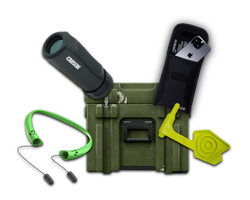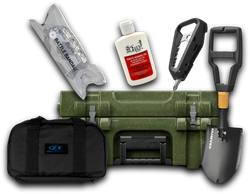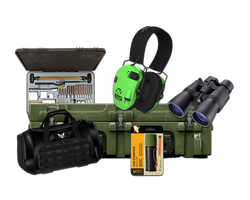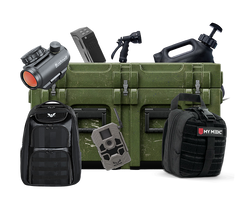How to Choose a Sleeping Bag: A Comprehensive Guide for the Tactical Adventurer
Table of Contents
- Introduction
- Understanding Temperature Ratings
- Insulation Types: Down vs. Synthetic
- Sleeping Bag Shapes: Mummy, Rectangular, and Semi-Rectangular
- Features to Look For
- Care and Maintenance
- Crate Club: Your Resource for Tactical Gear
- Conclusion
- FAQ
Introduction
Imagine this: it's a crisp night in the wilderness, the stars are twinkling overhead, and you're nestled inside your tent, ready to drift off to sleep. But as you settle into your sleeping bag, a chill runs down your spine. The bag is too thin for the dropping temperatures, and you find yourself shivering instead of resting. The difference between a good night’s sleep and a miserable one often boils down to one crucial piece of gear: your sleeping bag.
Selecting the right sleeping bag is not merely a matter of comfort; it can be a matter of safety when you're out in the elements. With countless options available, from temperature ratings to materials and designs, the task can feel overwhelming. Understanding how to choose a sleeping bag tailored to your specific needs is essential for anyone who enjoys camping, backpacking, or survival outings.
By the end of this blog post, you will have a solid understanding of the key factors to consider when choosing a sleeping bag. We will explore everything from temperature ratings to materials, features, and how to properly care for your sleeping bag. Additionally, we'll highlight how Crate Club's curated selection of tactical gear can enhance your outdoor experience.
Get ready to dive deep into the world of sleeping bags and arm yourself with the knowledge you need to make an informed decision that will keep you warm and comfortable on your next adventure.
Understanding Temperature Ratings
What Are Temperature Ratings?
Temperature ratings indicate the lowest temperature at which a sleeping bag will keep an average person warm. They are crucial for ensuring that you don’t end up too cold or too hot during your outdoor escapades. Sleeping bags come with various ratings, typically expressed in degrees Fahrenheit or Celsius, and are influenced by several factors, including insulation type, bag construction, and user comfort preferences.
Different Types of Temperature Ratings
-
Seasonal Ratings:
- Summer Bags: Generally rated for temperatures above 32°F (0°C). Ideal for warm-weather camping.
- Three-Season Bags: Suitable for temperatures ranging from 20°F to 32°F (-6°C to 0°C). These are versatile bags that work well in spring, summer, and fall.
- Winter Bags: Rated for temperatures below 20°F (-6°C) and often used for winter camping or mountaineering.
-
Comfort Ratings vs. Lower Limit Ratings:
- Comfort Rating: The temperature at which the average user will feel comfortable and sleep well.
- Lower Limit Rating: The lowest temperature at which the user is predicted to stay warm, but may not be comfortable.
Choosing the Right Temperature Rating
When selecting your sleeping bag, consider the coldest temperatures you might encounter. A good rule of thumb is to choose a bag that is rated at least 10°F lower than the lowest temperature you expect. If you tend to be a colder sleeper, consider opting for a bag with an even lower rating.
For instance, if you’re planning a trip where nighttime temperatures could drop to 30°F (-1°C), a sleeping bag rated for 20°F (-6°C) would be a wise choice.
Insulation Types: Down vs. Synthetic
Down Insulation
Down insulation is made from the soft, fluffy undercoating of ducks or geese and is known for its excellent warmth-to-weight ratio. Here are some benefits and drawbacks:
Benefits:
- Lightweight: Down bags are typically lighter than synthetic options.
- Compressibility: They can be packed down smaller, making them ideal for backpacking.
- Warmth: Down has excellent insulating properties, providing superior warmth.
Drawbacks:
- Price: Down sleeping bags can be more expensive than their synthetic counterparts.
- Moisture Sensitivity: Down loses its insulating properties when wet and takes longer to dry.
- Ethical Concerns: Some consumers may prefer to avoid animal products.
Synthetic Insulation
Synthetic insulation is made from polyester fibers and is designed to mimic down's insulating properties. Let’s explore its pros and cons:
Benefits:
- Moisture Resistance: Synthetic bags retain their insulating properties when wet and dry faster.
- Affordability: Generally more budget-friendly than down options.
- Easy Care: Synthetic bags are often machine washable.
Drawbacks:
- Weight: They are generally heavier and bulkier than down bags.
- Durability: Synthetic insulation may not last as long as down.
Making Your Choice
Choosing between down and synthetic insulation largely depends on your camping style, budget, and the conditions you expect to encounter. For cold, dry conditions, down may be the better option, while synthetic is preferable for wet or unpredictable weather.
Sleeping Bag Shapes: Mummy, Rectangular, and Semi-Rectangular
The shape of your sleeping bag affects both comfort and thermal efficiency. Here’s a breakdown of the most common shapes:
Mummy Bags
Mummy bags are tapered at the feet and wider at the shoulders, minimizing dead air space, which helps retain warmth.
Pros:
- Lightweight and compact.
- Excellent heat retention.
Cons:
- Can feel constricting for some users.
- Limited room for movement.
Rectangular Bags
Rectangular bags provide more space and comfort, resembling a traditional blanket.
Pros:
- Roomy and comfortable.
- Versatile; can be unzipped and used as a blanket.
Cons:
- Heavier and bulkier.
- Less efficient at retaining heat compared to mummy bags.
Semi-Rectangular Bags
A hybrid between mummy and rectangular bags, semi-rectangular bags offer a balance of warmth and comfort.
Pros:
- More room than a mummy bag, but retains heat better than a rectangular bag.
- Suitable for various sleeping positions.
Cons:
- May not perform as well as a mummy bag in cold conditions.
Choosing the Right Shape
Select a shape based on your comfort preferences and the conditions you expect. If you prioritize warmth and weight, a mummy bag is likely your best bet. For comfort and versatility, consider a rectangular or semi-rectangular bag.
Features to Look For
When selecting a sleeping bag, consider additional features that can enhance your experience:
Zippers and Draft Collars
- Zippers: Look for high-quality, snag-free zippers. Some bags offer dual zippers for versatile venting options.
- Draft Collars: These are insulated tubes around the neck area that help keep warmth in.
Hood and Foot Box
- Hood: A well-designed hood can significantly improve warmth retention. Look for bags with adjustable hoods for a snug fit.
- Foot Box: A boxy foot area allows for more room and comfort for your feet.
Compression Stuff Sack
A compression sack is essential for packing your sleeping bag down to save space in your backpack. Look for a durable, lightweight material that provides easy access to your bag.
Care and Maintenance
To prolong the life of your sleeping bag, proper care and maintenance are crucial. Here are some tips:
Washing Your Sleeping Bag
- Frequency: Only wash your sleeping bag when necessary. Frequent washing can wear out the insulation.
- Method: Use a front-loading washing machine on a gentle cycle with a mild detergent. For down bags, use a detergent specifically designed for down.
Drying
- Air Drying: If possible, air dry your bag outdoors. Ensure it is completely dry before storing it to prevent mildew.
- Low Heat Drying: If using a dryer, use the lowest heat setting and include dryer balls to help fluff the insulation.
Storage
- Loosely Stuffed: Store your sleeping bag loosely in a breathable storage sack rather than a compressed stuff sack to maintain insulation loft.
- Cool, Dry Place: Keep it in a cool, dry place away from direct sunlight.
Crate Club: Your Resource for Tactical Gear
At Crate Club, we understand the importance of high-quality gear for your outdoor adventures. Our subscriptions offer a curated selection of tactical gear, survival tools, and equipment delivered to your doorstep monthly.
Subscription Tiers
- Lieutenant Tier: For casual tacticians at $49.99/month, receiving gear valued at $89. Perfect for those beginning their outdoor journey.
- Captain Tier: At $99.99/month, enjoy a mix of survival and tactical gear valued at $153. Ideal for everyday use and preparedness.
- Major Tier: For experienced survivalists at $199.99/month, this tier offers premium gear valued at $305, ensuring you have the best equipment for any challenge.
- General Tier: For serious adventurers at $399.99/quarterly, receive gear valued at $561, including real-issue tactical gear.
Explore our subscriptions here: Crate Club Subscription Services.
Additionally, our Crate Club Shop features a selection of tactical gear available for individual purchase, ensuring you can find what you need for your next expedition.
Conclusion
Choosing the right sleeping bag is paramount for enjoying your outdoor adventures. Understanding temperature ratings, insulation types, bag shapes, and essential features will equip you with the knowledge to make an informed decision.
A well-chosen sleeping bag not only enhances comfort but also ensures safety in unpredictable environments. As you prepare for your next camping trip, consider how Crate Club's curated gear can support your needs and elevate your outdoor experience.
Are you ready to explore the great outdoors with confidence? Start by selecting the perfect sleeping bag, and remember that with the right gear, every adventure is possible.
FAQ
1. How do I know what temperature rating I need for my sleeping bag?
Choose a sleeping bag with a rating at least 10°F lower than the lowest temperature you expect to encounter. If you tend to sleep cold, opt for a bag rated even lower.
2. What's the difference between down and synthetic sleeping bags?
Down bags are lighter and provide better insulation but can be less effective when wet. Synthetic bags are more affordable, retain warmth when damp, and are easier to care for.
3. Can I use a sleeping bag in all seasons?
While some sleeping bags are designed for year-round use, it's often best to have multiple bags for different seasons to ensure comfort and safety.
4. How do I properly wash and care for my sleeping bag?
Wash your sleeping bag only when necessary using a front-loading machine, and air dry it fully before storage. Store it loosely in a breathable sack.
5. Where can I find high-quality sleeping bags and tactical gear?
Crate Club offers a curated selection of sleeping bags and tactical gear through their subscriptions and shop. Explore the offerings at Crate Club Shop to find what suits your needs.
Armed with this knowledge, you're now prepared to choose the sleeping bag that best fits your adventures. Whether you're a casual camper or a seasoned survivalist, quality gear is essential for a successful outing. Gear up and get ready to embrace the great outdoors!
Share this article



